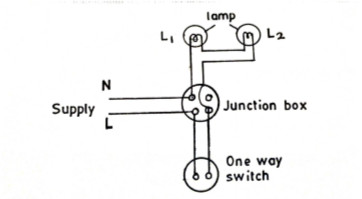QUESTION 3
(a) (i) State three advantages of a well-designed lighting scheme.
(ii) State four factors that affect the illumination of a room.
(b) List five steps in the procedure for threading conduit.
(c) Explain each of the following terms in Electrical Installation:
(i) fuse;
(ii) current rating;
(iii) fusing current.
(d) Draw and label a diagram to illustrate the wiring of two points of light connected in series and controlled by a one-way switch.
(e) Define entrepreneurship.
Observation
3(a): Most of the candidates answered the questions regarding illumination correctly.
3(b): Most of the candidates failed to list the steps in the correct chronological order.
3(c): The candidates demonstrated average performance in explaining fuses and related terminologies.
3(d): Many candidates successfully demonstrated their understanding of connecting two light points in series and controlling them with a one-way switch through a clearly labelled diagram.
3(e): Most of the candidates accurately defined the term entrepreneurship.
The expected answers include:
Expected response:
(a) (i) ADVANTAGES OF A WELL-DESIGNED LIGHTING SCHEME
- It avoids shadow/proper lighting/brightness
- Provides sufficient distribution of light all over the working plane
- Provides aesthetics (beautiful appearance)
- It is cost-effective
- Moderate energy consumption
- Utilization/diversity factor
- Provides room for expansion
b. FACTORS THAT AFFECT THE ILLUMINATION OF A ROOM
- The type of lighting system
- Mounting height of the fittings
- Colour of wall/ceiling
- Shape and dimension of room
- Age of the lamp/depreciation
- Maintenance factor
- Coefficient of utilization
- Intensity/efficiency of the lamp
- Uniformity of the illumination on the working plain
- Diffuser
c. PROCEDURES FOR THREADING CONDUIT
- Cut the conduit
- Tapper the end of the conduit with file/reamer to remove burrs
- Place conduit on the vice and tight firmly
- Lubricate the part to be threaded
- Select the die appropriate for the conduit
- Press the dies on the conduit and start the threading
- The dies should be reversed to reversed half a turn at regular intervals to prevent chocking of the thread with swarf
- When the threading is completed, smoothen the end with a reamer or a file
Do not mark if the order is not followed.
c. (i) EXPLANATION OF FUSE
It is a device for opening a circuit by means of a conductor/element designed to melt when excess current flows through
ii. CURRENT RATINGS
It is the maximum current that the fuse element will carry continuously without undue deterioration.
iii. FUSING CURRENT
It is the minimum current at which the fuse element will melt.
- d.

(e)
|
|
It is the act of creating a business in order to make profit OR
It is a capacity to develop, organize and manage a business with a view of making profit in the phase of risks.
